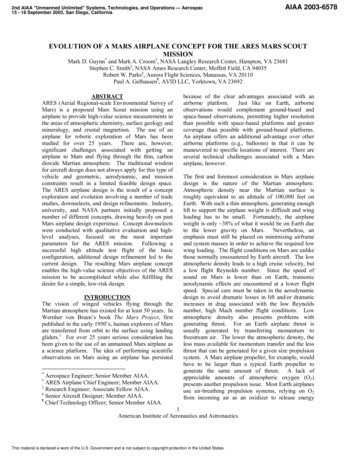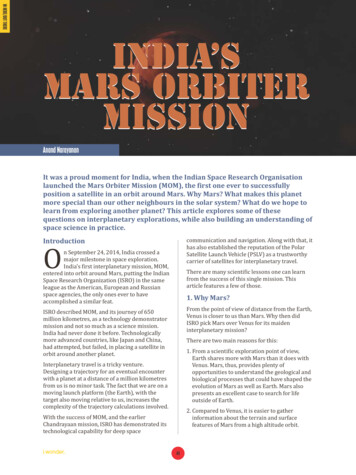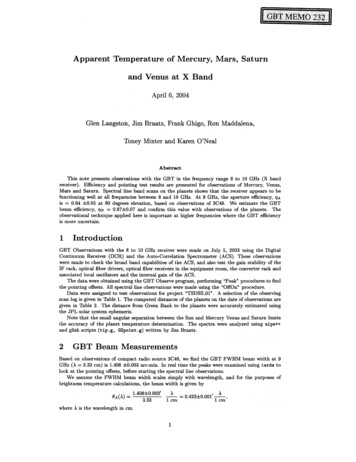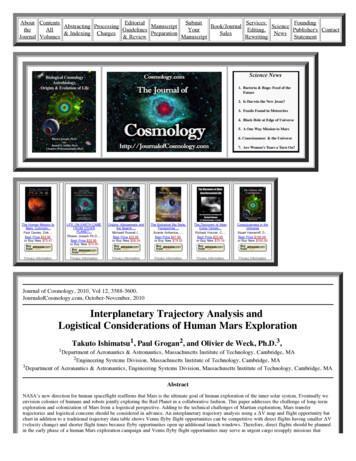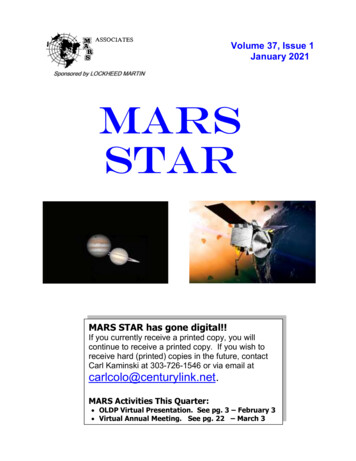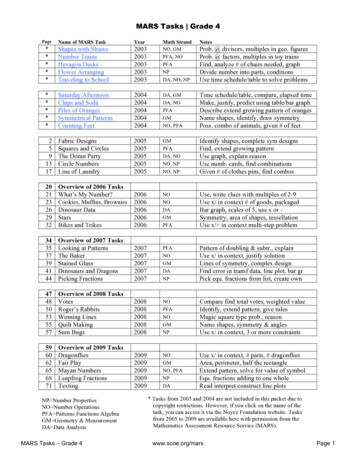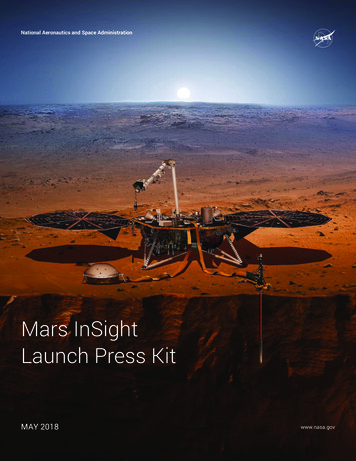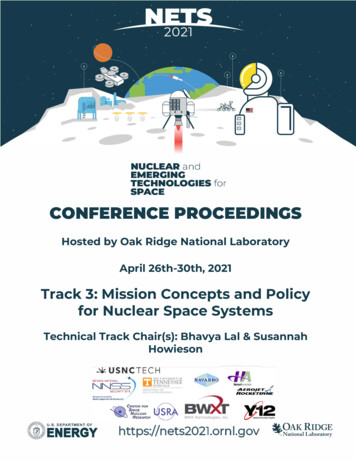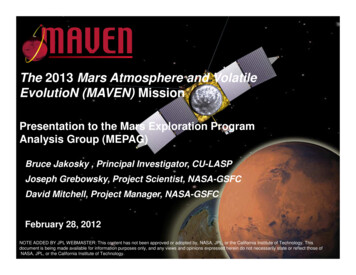
Transcription
The 2013 Mars Atmosphere and VolatileEvolutioN (MAVEN) MissionPresentation to the Mars Exploration ProgramAnalysis Group (MEPAG)Bruce Jakosky , Principal Investigator, CU-LASPJoseph Grebowsky, Project Scientist, NASA-GSFCDavid Mitchell, Project Manager, NASA-GSFCFebruary 28, 2012NOTE ADDED BY JPL WEBMASTER: This content has not been approved or adopted by, NASA, JPL, or the California Institute of Technology. Thisdocument is being made available for information purposes only, and any views and opinions expressed herein do not necessarily state or reflect those ofNASA, JPL, or the California Institute of Technology.1
Project OverviewBruce Jakosky, Principal Investigator2
MAVEN Status In Brief MAVEN is on track technically, on schedule, and on budget.Currently in the middle of build of flight instruments, s/c avionics, s/c structureand propulsion.ATLO (Assembly, Test, and Launch Ops) starts this summer.20-day launch window opens on 18 November 2013.MAVEN is fully funded in the recently released President’s budget.3
Science SummaryAncient ValleysMars’ atmosphere is cold and dry today, but there wasonce liquid water flowing over the surface.Where did the water and early atmosphere go? H2O and CO2 can go into the crust or be lost tospace. MAVEN will focus on volatile loss to space.Turn-off of the Martian magnetic field allowed turn-on of solar-EUV andsolar-wind stripping of the atmosphere approximately 3.7 billion yearsago, resulting in the present thin, cold atmosphere.4
There Is Compelling Evidence ForChanges In The Atmosphere And Climate Geomorphological and mineralogical features on ancient surfaces indicativeof widespread or stable liquid water.Isotopic fractionation that is indicative of loss of a significant fraction of thevolatiles to space (e.g., enrichment of D/H, 15N/14N, 38Ar/36Ar).Direct measurement of escaping ions at the present epoch (by MEX).(Bishop et al., 2008; Barabash et al., 2007)5
Potential Importance of the Role ofLoss to Space The history of liquid water and of the atmospheredetermine Mars’ potential for life throughout time. There is abundant evidence for climate change andatmospheric evolution. Loss of atmospheric CO2, N2, and H2O to spacehas been an important mechanism for atmosphericevolution, and may have been the dominantmechanism.Only by understanding the role of escapeto space will we be able to fully understandthe history of the atmosphere, climate, andwater, and thereby understand Martianhabitability.6
MAVEN Science Questions Determine the structure and composition of the Martian upperatmosphere today Determine rates of loss of gas to space today Measure properties and processes that will allow us to determinethe integrated loss to space through timeMAVEN will answer questions about the history of Martian volatiles andatmosphere and help us to understand the nature of planetary habitability.7
MAVEN Will Measure the Drivers,Reservoirs, and Escape RatesPlasmaProcessesSolar InputNeutralProcesses MAVEN will determine the presentstate of the upper atmosphere andtoday’s rates of loss to space. Essential measurements allowdetermination of the net integrated loss tospace through time.8
The MAVEN Science Instruments9
The MAVEN Science TeamOverall science leads:Bruce Jakosky (PI)Bob Lin (DPI)Joe Grebowsky (PS)Janet LuhmannNGIMS:Paul MahaffyMehdi BennaWayne KasprzakIUVS:Nick SchneiderBill McClintockErik RichardIan StewartJohn ClarkeFranck MontmessinMAG:Jack ConnerneyJared EspleySWEA:David L. MitchellChristian MazelleJean-Andre SavaudDominique ToublancSWIA:Jasper HalekasDavin LarsonSTATIC:Jim McFaddenDavid BrainBill PetersonFrancois LeblancLPW:Bob ErgunGreg DeloryLaila AnderssonFrank EparvierTom WoodsPhil ChamberlinAnders ErikssonSEP:Davin LarsonJasper HalekasRob LillisAAG:Richard ZurekBob TolsonDarren BairdIDS:Tom CravensXiaohua FangJane FoxRoger YelleAndy Nagy10
Additional Scientist OpportunitiesSupport through the JPL Critical Data Program: Steve Bougher, Univ. of Michigan, Coupled MGCM-MTGCM Marsthermosphere simulations and resulting data products in support of theMAVEN mission Paul Withers, Boston Univ., Thermospheric variability observed by pastaerobraking missions and radio occultation experiments Scott England, Berkeley, MAVEN critical data products from MGS MAG/ERMAVEN Participating Scientist Program: Participating Scientist Program is being planned for MAVEN; details still beingworked out.Currently aiming for proposals to be due early in 2013 and for selectedscientists to come on board at about the time of launch.We are planning for a Fall 2012 MAVEN community workshop to provideopportunity to discuss details of the mission, instruments, and science with thescience team. Details will be made available as soon as they are finalized.11
MAVEN Mission ArchitectureTen-Month Ballistic Cruise To MarsLaunch Window:November 18 –December 7, 2013One Year of Science OperationsOrbit Insertion:22 Sept 201412
The MAVEN Spacecraft2550 kg Launch wet mass: 2550kg Spacecraft dry mass:903903kg kgWWat at Mars aphelion Power: 1135113513
The MAVEN SpacecraftSame weight fully loaded as aGMC Yukon – 2550 kg.Same length as a school bus –wingtip-to-wingtip length of 45 ft.14
Elliptical Orbit Allows Measurement of AllRelevant Regions of Upper Atmosphere Nominal periapsis near 150 km.Five “deep-dip” campaigns with periapsis near 125 km.15
MAVEN Orbit and Primary Mission Elliptical orbit to provide coverage of all altitudes The orbit precesses in both latitude and local solar time One-Earth-year mission allows thorough coverage of near-Mars space16
Latitude and Local Time Coverage One-Earth-year mission provides coverage of all local solar times and mostlatitudes.Figure shows periapsis location for each orbit.Latitude of Periapsis Relative to Sun Start of sciencemissionPrimary missionDeep-dipsEclipsesLongitude of Periapsis Relative to Sun17
MAVEN’s Timing In The Solar CycleMAVENPrimaryMission18
Constraining the Total AtmosphericLoss Through TimeHistory of Solar ActivitySolar windpickupIon outflowSputteringPhotochemical andJeans escapeIon bulkescapePhysical & Empirical ModelsNGIMSIUVSIsotope Ratios19
Mission and Science Operations Will UtilizeExisting Facilities At LM And LASP MAVEN utilizes extensive operationalfacilities at LM (MOC) and LASP (SOC). Both LM and LASP have very experiencedoperations teams and well-developedprocedures.Lockheed Martin Mission Support Area All operational phases of the MAVENmission have been carried out at Mars onprevious missions.LASP Mission Operations Center20
MAVEN Is Committed to a Strong Educationand Public Outreach (EPO) Program MAVEN EPO builds on existing high-quality programs and partnerships tobring unique MAVEN products to a wide range of national audiences. Our projects include in-class and out-of-class educational materials for K-12students and educators with an emphasis on underserved/underrepresentedaudiences: Girls, Hispanic students, Native Americans, and rural populations. We are creating multi-direction exchange with the general public through theapplication of New Media tools—including Twitter, Facebook, tweetups, andprofessional development for New Media practitioners.2121
MAVEN Will Continue The Successful“Follow The Water” ThemeMGS, MPF, ODY, MER, MRO, MEx, PHX, upcoming MSL, are focused largely onthe history of the surface. MAVEN’s comprehensive approach will provide thehistory of the atmosphere as the necessary other half of the story.22
NASA’s Mars Exploration ProgramOperational / Recent2009Launch Year2011201320162018 & BeyondOdysseyMROMAVENMars ExpressCoopTrace GasOrbiterMERPhoenix(completed)Mars Science Lab23
MAVEN ScheduleSIR/ATLOStart28 February 2012 MAVEN concept developed starting in early 2004Proposal submitted in 2006Selected for competitive Phase A, early 2007Selected for development for flight, Sept. 2008Preliminary Design Review held in July 2010MAVEN Confirmed in October 2010Critical Design Review in July 2011As of today, launch is 1 year, 8 months, 19 days away!24
Science ImplementationJoe Grebowsky, Project Scientist25
Evidence for Current Loss to Space Direct detection of energetic ionospheric ions moving away from theplanet by Mars Express and Phobos Missions Mars Global Surveyor observations of atmospheric depletion inresponse to a Solar Energetic Particle (SEP) event All missions lacked relevant measurementsNeutral density at 195 km at 2 amMEX Escape (Nilsson et al., 2010)MGS Atmosphere Depletion (Lillis et al., 2006)26
Escape Involves EUV, Solar Particles,Magnetic Fields and Neutral AtmosphereKey:27
The Instruments28
LPW – EUV MonitorFrank Eparvier, LASPMeasurement Objectives: Solar EUV irradiance variability at wavelengthsimportant for ionization, dissociation, andheating of the upper atmosphere (wavelengthsshortward of H Ly-α 121.6 nm)EUV Engineering ModelTechnical details and heritage: Three photometers at key wavelengthsrepresenting different temperature solaremissions (0.1-7, 17-22, and 121.6 nm) EUV hardware is part of LPW instrument Heritage from TIMED, SORCE, SDO and rocketinstruments Full spectrum (0-200 nm) derived frommeasurements using Flare Irradiance SpectralModel (FISM).EUV detector bandpasses29
Imaging Ultraviolet Spectrometer (IUVS)Nick Schneider, LASPCAD drawing of IUVSMeasurement objectives: Vertical profiles of neutrals and ions throughlimb emissions and lower atmosphere propertiesfrom stellar occultations Disk maps from near apoapsis. D/H and hot oxygen coronal mapping Atmospheric properties below homopauseFlight Data Processing UnitTechnical details and heritage: Imaging spectroscopy from 110-340 nm, withresolution of 0.5 nm Vertical resolution of 6 km on limb, horizontalresolution of 200km in nadir viewing Detectors: Image-intensified 2-D active pixelsensors Most recent heritage from AIM CIPSModel spectra and derived profiles30
Neutral Gas and Ion Mass Spectrometer (NGIMS)Paul Mahaffy, GSFCFightCAD drawing of NGIMSMeasurement Objectives: Basic structure of the upper atmosphere (He, NO, CO, N2, NO, O2, Ar and CO2) and ionospherefrom the homopause to above the exobase Stable isotope ratios, and variationsFlight Quadrupole HousingTechnical Details:AntechamberClosed Ion SourceIonization RegionNeutral Gasand Ions Quadrupole Mass Spectrometer with open andclosed sources Closed source measurements: non-reactiveneutrals Open source species: neutrals and ions Mass range: 2 - 150 Da Mass resolution: 1 Da over entire mass range Modes: scan entire spectra or adapt to fixedmasses Sensitivity: 10-2 (counts/s)/ (particles/cm-3) Heritage from Galileo GPMS, Pioneer VenusONMS, CASSINI INMS, Contour NGIMSBayard-Alpert (BA) gaugeQuadrupole DeflectorCollimatorIon Lens SystemOpen Ion SourceIonization RegionQuadrupoleMass AnalyzerIon DetectorSecondary Electrons31
Langmuir Probe and Waves (LPW)Bob Ergun, LASPMeasurement Objectives: Electron temperature and number densitythroughout upper atmosphere Electric field wave power at low frequenciesimportant for ion heating Wave spectra of naturally emitted and activelystimulated Langmuir waves to calibratedensity measurementsLPW Stacer boom (undeployed)Technical details and heritage: Cylindrical sensors on two 7-meter booms I-V sweeps (at least 50 V range) of sensors Low frequency E-field wave power sensing(f: 0.05-10 Hz); sensitivity10-8 (V/m)2/Hz (f0/f)2where fo 10 Hz and 100% bandwidth E-Spectra measurements up to 2 Mhz White noise (50 kHz-2 MHz ) sounding Thermal Electron density 100 to 106 cm-3 Electron temperatures 500 to 5000o K Heritage from THEMIS and RBSP32
Magnetometer (MAG)Jack Connerney, GSFCMeasurement objectives: Vector magnetic field in the unperturbed solarwind (B 3 nT), magnetosheath (B 10-50 nT),and crustal magnetospheres (B 3000 nT) Ability to spatially resolve crustal magneticcusps (horizontal length scales of 100 km)MAG Flight ModelTechnical details and heritage: Magnetic field over a dynamic range of 0.1 nTMGS MAG measurements:to 60,000 nT, with 1 sec time resolution (4 kmspatial resolution), 1 angular determination,and5% precision on scalar value Heritage: MGS, Voyager, AMPTE, GIOTTO,CLUSTER, Lunar Prospector, MESSENGER andothers; identical to MAG on STEREO33
Solar Wind Ion Analyzer (SWIA)Jasper Halekas, SSLMeasurement objectives: Density and velocity distributions of solarwind and magnetosheath ions to determinethe charge exchange rate and the bulkplasma flow from solar wind speeds ( 350to 1000 km/s) down to stagnatingmagnetosheath speeds (tens of km/s).SWIA EngineeringModelTechnical details and heritage: Proton and alpha velocity distributionsfrom 50 to 2000 km/s, density from 0.1 to 100 cm-3. Energy resolution of 10% andangular resolution of 22.5 (4.5 aroundsun). Intrinsic time resolution of 4 s.Similar measurements provided by Wind: Heritage from Wind, FAST, and THEMIS.34
Solar Energetic Particle (SEP) AnalyzerDavin Larson, SSLMeasurement objectives: Characterize solar particles in an energy rangethat affects upper atmosphere and ionosphericprocesses ( 120 – 200 km) Time resolution adequate to capture major SEPevents ( 1 hour)SEP Engineering ModelTechnical details and heritage: Two dual double-ended telescopes Four look directions/species, optimized forparallel and perpendicular Parker Spiral viewing Protons and heavier ions from 25 keV to 12MeV Electrons from 25 keV to 1 MeV Energy fluxes 10 to 106 eV/cm2-sec-ster-eV Better than 50% energy resolution Nearly identical to SST on THEMISPrompt Mev proton enhancement after solardisturbance and at arrival of shock (Reams, 1999)35
Solar Wind Electron Analyzer (SWEA)David L. Mitchell, SSLMeasurement objectives: Measure energy and angle distributions ofelectrons in the Mars environmentDetermine electron impact ionization ratesMeasure magnetic topology via loss conemeasurementsMeasure primary ionospheric photoelectronspectrumMeasure auroral electron populationsEvaluate plasma environmentSWEA FlightAnalyzerTechnical details and heritage:MGS measurements of auroral electrons: Hemispherical Electrostatic AnalyzerElectrons with energies from 5 eV to 5 keVFOV 360o X 130oAngular resolution 22.5o in azimuth, betterthan 14o in elevation Energy fluxes 103 to 109 eV/cm2-s-ster-eV Energy resolution 18% (capability for 9%below 50 eV) Based on STEREO SWEA36
Suprathermal and Thermal Ion Composition (STATIC)Jim McFadden, SSLMeasurement objectives: Escaping ions and processes Composition of thermal to energetic ions; energydistributions and pitch angle variations Ionospheric Ions 0.1-10 eV Tail superthermal ions (5-100eV) Pick-up Ions (100-20,000 eV) Key ions H , O , O2 , CO2 STATIC EngineeringModelTechnical details and heritage: Toroidal Electrostatic Analyzer with Time of Flightsection Mass range 1-70 AMU, M/M 4 Energy range 1 eV to 30 keV, E/E 15% FOV 360o X 90o Angular resolution 22.5oX6o Energy flux 104 to 108 eV/cm2-s-sr-eV(to 1012 w/attenuators for low energy beam) Can be oriented to measure either upwelling/downwelling ions or horizontal flows Heritage from Cluster CODIF.Laboratory spectrum from Engineering Model37
Instrument Placement On SpacecraftBody-mounted instrumentspoint at sun or solar wind: EUV (part of LPW) SWIA SEPSEPBoom-mounted instruments areisolated from S/C magnetic andelectric fields: LPW SWEA MAG (boomlets at end of solararrays)Instruments on ArticulatedPayload Platform orient w.r.t.planet or ram direction (fields ofview are shown): IUVS NGIMS STATIC38
Measurements Throughout The OrbitIUVSCoronal Scans39
Instruments Sample all the Relevant Physics40
Measurement Approach Summary MAVEN’s orbital period, inclination, and periapsis altitude willprovide the best comprehensive coverage of Mars escaperelated regions possible for a one-Earth-year mission The instruments, which have high heritage, will sample allescape processes Phasing of the mission on the declining phase of the solarcycle maximizes the range of solar variability inputs needed forextrapolating loss vs. solar inputs backwards in the history ofthe solar system41
Project Status and PlansDavid F. Mitchell, Project Manager42
The MAVEN Project’s JourneyFrom Proposal Days Image Credit: Corby Waste, NASA-JPL to Science at MarsSIR/ATLOStartWe are tracking right onplan to launch next year!43
Management Principal Investigator (PI)-mode mission, PI in charge– PI operates under a separate LASP contract from NASA Headquarters Goddard manages the project for the PI Instrument development grouped in packages closely aligned withinstitutional responsibilities– Goddard – Neutral Gas and Ion Mass Spectrometer (NGIMS)– Laboratory for Atmospheric and Space Physics (LASP) - Remote Sensing – IUVSand RSDPU– Space Sciences Laboratory (SSL) - Particles and Fields – STATIC, SEP, SWIA,SWEA, LPW-EUV (LASP/SSL provided), MAG (GSFC provided), and PFDPU Lockheed Martin (LM)-Denver provides the spacecraft, instrumentintegration and mission operations LASP provides Science Operations Jet Propulsion Laboratory (JPL) provides Navigation support, DeepSpace Network (DSN), and Electra telecom relay hardware/ops (GFE)44
The MAVEN Spacecraft 3-axis attitude control Mono-propellant propulsion system Single-fault tolerant during all critical events Launch (Wet) Mass: 2550 kg max Spacecraft Dry Mass: 903 kg max Power: 1135 W at Mars AphelionLPW (2)SWEASWIASEP“Gull-Wing” Solar ArraysFixed HGAMAG (2)SEPArticulated PayloadPlatform(IUVS/STATIC/NGIMS)45
Mission ArchitectureTen Month Ballistic Cruise to Mars18 Nov 2013 (Open)7 Dec 2013 (Close)Type-II TrajectoryEarly Cruise20-Day Launch PeriodLV: Atlas V 401Late CruiseNorthern Approach 1233 m/s VOrbit Insertion:22 Sept 2014 (Open)28 Sept 2014 (Close)One Year of Science OperationsCapture Orbit:35 hour period380 km P275 inclination46
Major Partner InstitutionsBerkeley,CABoulder, COLittleton, COPasadena, CAGSFCGreenbelt, MD47
MAVEN Team at CDR (July 2011)48
Project Status Successfully completed the “CDR Season” with a total of 32 reviewsbetween February 2011 and January 2012 Currently building and testing flight hardware across the board with thepayloads and spacecraft, as well as with the ground systems MAVEN/Atlas V Mission Integration activities are proceeding right ontrack with planned launch in November 2013 The Project has maintained solid schedule and cost margins sinceConfirmation Review in October 201049
Spacecraft Core Structure50
Spacecraft HardwareSpacecraft ThrustersSpacecraft Structure in the StaticTest Reaction ChamberSolar Array (Outboard Panel)51
Payload HardwareMagnetometer SensorFlight Model (FM)Neutral Gas and Ion MassSpectrometer (NGIMS) QMS IonSource Assembly (FM)Remote Sensing DataProcessing Unit (RSDPU)IUVS Spectrograph CaseFlight ModelElectra UHF TransceiverFlight ModelSupraThermal and Thermal Ion Composition(STATIC) Engineering Model (EM)Solar Wind Electron Analyzer (SWEA)Flight Model Analyzer & PedestalSolar Energetic Particle (SEP)Engineering ModelLangmuir Probe and Waves(LPW) Boom (EM)Solar Wind Ion Analyzer (SWIA)Engineering ModelParticles & FieldsData Processing Unit(PFDPU) Partial StackExtreme UltraViolet (EUV)Engineering Model52
MAVEN Pre-Environmental Review (PER) andSystem Integration Review (SIR) ScheduleElementDateRemote Sensing Package Pre EnvironmentalReview (PER), at CU-LASPApril 10, 2012Particle & Fields Package PER, at SSLMay 22, 2012System Integration Review, at Lockheed MartinNGIMS PER, at NASA-GSFCKey Decision Point-D (KDP-D), at NASA-HQOrbiter PER, at Lockheed MartinJune 25 – 28, 2012August 8, 2012 September 11, 2012January 25, 201353
MAVEN Master Schedule*2/22/122009MAVEN Master ScheduleQ4145672010Q3Q4SRAMAVEN Mission Q4Q1Q2LASP 4/27 7/11IBRCDRNeutral Gas & Ion MassSpectrometer (GSFC)Remote SensingPackage (LASP)Particles & FieldsPackage (SSL)PDRCDR5/26PDR6/3CDRMission Operations/GroundData ProcessingMAVEN S/C Integration &TestQ2Ph. EMAVEN LRDORRMissionSIRQ111/188/89/1111/11 FRRPSRLRR7/1611/17Avail12/11 Deliver to LMA10/1RS Availfor CalRS Avail to LMA11/14 RS Suite Deilvery to LMA10/16/17PDR6/8CDR10/16/14PDR5/237/13 9/11SSL Avail11/13 SSL Deliver to LMA9/21CDRElectra (JPL)MAVEN SpacecraftDevelopmentQ4Phase DKDP-D7/18 PBA2014Q36/2511/1 3/317/12Q2Phase CKDP-CMissionPDRQ2MAVEN Payload Suite8/23 Delivery to LMA10/18Q1Phase B11/183Q2MAVEN Project PhasesMAVENK/O2Q16/10S/C PDR3/22S/C CDRRcv PrimeStruc Prop Avail7/27 Prop Sub-Syst Del 25PDRGDS2.011/182/131/246/256/102/1MOS-GDS GDSCDR3.0 11/299/10GDSGDS4.0 Inst Integ 5.0Start8/6 Ship KSC10dFunded Sched.Margin10d9d12d15dSched. Slack1112Launch Operations (KSC)Launch Vehicle8/12Critical 818dLVMRR ShipATP11/1* Currently holding 97 days of funded schedule marginLV 6/18 9/18D/R54
Budget Status: GREEN MAVEN continues to execute to the budget approved at theConfirmation Review in October 2010 Recent rollout of the President’s fiscal year 2013 budget showscontinuing support for the MAVEN mission As of January 31, 2012, the MAVEN Team had expended 46% of thetotal budget through Phase D. We currently have solid reserves per theplan through launch.55
Project Focus Points Successful build and test of hardware at all institutions and ensure aclear path to ATLO (Assembly, Test & Launch Operations) starting thissummer. This includes closing out paperwork in a timely manner andnot allowing a bow wave of open paper to build up. Readying the mission operations, science data, and ground systemteams for ATLO support, early rehearsals, and the November 2012Mission Operations Review. Pressures of the 20-day planetary launch window: Working issues asthey arise in an efficient and safe manner. Maintaining Phase C-D cost levels within plan and ensuring properreserve levels for all remaining Project phases. Keeping the entire team in synch as it evolves across the missionelements (spacecraft, instruments, ground systems, operations,science, launch service) in the run to launch next year.56
Project Manager’s Summary The MAVEN Project has made significant strides in Phase C– The team is very experienced and continues to work well together as we have for thepast seven plus years.– Spacecraft, instrument and ground systems hardware are being built/tested across thepartner institutions; launch service is on track.– MAVEN design incorporates significant heritage from previously flown spacecraft andinstrument systems. This is now bearing itself out in how things are coming togetherin early interface tests, hardware build, and overall team execution.– We are committed to delivering a successful mission within the cost cap and onschedule. Thus far we have met every one of our major milestones. This is criticallyimportant given MAVEN’s tight planetary launch window.– With the progress made since CDR, we are well positioned to build/deliver/testhardware, complete Phase C over the next 6 months, and begin ATLO this summer.MAVEN is on track technically, on schedule and on budget with solid reservesSIR/ATLOStart57
Want to Follow Us?We’re on Facebook and Twitter: MAVEN2MARSand on the edu/maven58
59
Mission DescriptionMission Objectives Determine the role that loss of volatiles from the Mars atmosphere to space has playedthrough time, exploring the histories of Mars’ atmosphere and climate, liquid water, andplanetary habitability Determine the current state of the upper atmosphere, ionosphere, and interactions with solarwind Determine the current rates of escape of neutrals and ions to space and the processescontrolling them Determine the ratios of stable isotopes that will tell Mars’ history of loss through timeOrganizationsMission Approach LASP – PI and science team; E/PO; science operations;IUVS and LPW instruments GSFC – project management; mission systems engineering;safety and mission assurance; project scientist; NGIMS andMAG instruments JPL – Electra Relay; Navigation; DSN; Mars Program Office SSL – Deputy PI; Particles and Fields Package management;STATIC, SEP, SWIA, and SWEA instruments; LPW probesand booms (IRAP provides the sensor for SWEA) LM – spacecraft; assembly, test and launch operations;mission operationsObtain detailed measurements of the upper atmosphere,ionosphere, planetary corona, solar wind, solar EUV andSEPs over a 1-year period, to define the interactions betweenthe Sun and Mars Operate 8 instruments for new science results:Particles and Fields Package (6 instruments):SWEA - Solar Wind Electron AnalyzerSWIA - Solar Wind Ion AnalyzerSTATIC - Suprathermal and Thermal Ion CompositionSEP - Solar Energetic ParticleLPW - Langmuir Probe and WavesMAG - MagnetometerLaunchIUVS - Imaging Ultraviolet Spectrometer On an Atlas V from KSC between 11/18/13 and 12/7/13NGIMS - Neutral Gas and Ion Mass Spectrometer Mars Orbit Insertion on 9/22/14 (for 11/18/13 launch) Fly 75 -inclination, 4.5-hour-period, 150-km-periapsis-altitudescience orbitWebsites Perform five 5-day “deep dip” campaigns to altitudes near 125km during the 1-year do.edu/maven/60
Project Organization ChartScience TeamManagement Advisory Group(GSFC, JPL, LM, LASP, SSL)Principal Investigator (Jakosky/LASP)Deputy PI (Lin/SSL)PS (Grebowsky/GSFC)Education & Public Outreach(Renfrow /LASP)Public Affairs (Neal-Jones/GSFC)Safety & Msn Assurance (Cheatom/GSFC)Project ManagementPM (Mitchell/GSFC)DPM (Cauffman/GSFC)DPM/R (Sparacino/GSFC)Procurement (Aqueche/GSFC)Finance (Plants, Hall, Lee,Baumann/GSFC)Project Support (Barker,Cumberbatch/GSFC)CM (Schmidt, Cusick/GSFC)Scheduling (Derkacz, Dolch/GSFC)EVM (Truss/GSFC)Systems EngineeringMSE (Houghton/GSFC)ISE/P.P. (Bartlett/GSFC)S/W Sys Mgr (Jackson/GSFC)Risk/Requirements (Safdie/GSFC)MissionDesign & Nav(Folta/GSFC)(Demcak/JPL)Mission and ScienceOperations(Gomez-Rosa/GSFC)(Sidney/LM Mission Ops)(Possel/LASP Science Ops)NOTE: Leads are shown in ItalicsAs of October 31, 2011Flight SegmentManager(Jarosz/GSFC)Flight eISM (Jedrich/GSFC)P&F y/GSFC)IM (King/GSFC)RS aPM(Epp/JPL)GSFC L/VInterface Mgr(Morrissey/GSFC)KSC L/V Mgr(Tatro/KSC)61
y ScienceAAGAssociation of American GeographersEMEngineering ModelINMSIon and Neutral Mass SpectrometerAIMAeronomy of Ice in the MesosphereEPOEducation and Public OutreachIRAPInstitute of Research for Astrophysics andAMPTEActive Magnetospheric Particle Tracer ExplorersEUVExtreme UltraVioletEUVMExtreme UltraViolet MicroscopeISEInstrument System EngineerAPPArticulated Payload PlatformeVElectron VoltISMInstrument Systems ManagerArArgonEVMEarned Value ManagementIUVSImaging Ultraviolet SpectrometerATLOAssembly, Test and Launch OperationsFASTFast Auroral Snapshot ExplorerI-VCurrent-Voltage sweeps (LPW)CDRCritical Design ReviewFISMFlare Irradiance Spectral ModelJPLJet Propulsion LaboratoryCIPSCloud Imaging and Particle SizeFMFlight ModelKKelvinCmcentimeterFOVField Of ViewK/OKick OffCMECoronal Mass EjectionFRRFlight Readiness ReviewKDPKey Decision PointCOCarbon MonoxideftfeetkeVkiloelectron VoltCO2Carbon DioxideGDSGround Data SystemkgkilogramCODIFComposition and Distribution Function AnalyzerGFEGovernment Furnished EquipmentkmkilometerCo-ICo-InvestigatorGPMSGalileo Probe Mass SpectrometerKSCKennedy Space CenterCUUniversity of ColoradoGSFCGoddard Space Flight CenterLASPLaboratory for Atmospheric and Space PhysicsCYCalendar YearHHydrogenLMLockheed MartinD/HDeuterium/Hydrogen (ratio)H2 OWaterLMALockheed MartinD/RDelivery/ReceiptHeHeliumLPWLangmuir Probe and WavesDaDaltonHGAHigh Gain AntennaLRDLaunch Readiness DatedegdegreeHQHeadquartersLRRLaunch Readiness ReviewDPMDeputy Project ManagerHzHertzLVLaunch VehicleDPM/RDeputy Project Manager/ResourcesIBRIntegrated Baseline ReviewMMillionDSNDeep Space NetworkICDInterface Control DocumentmMeterPlanetology62
Acronyms (continued)m/smeter/secondMAGMagnetometerMAVENMars Atmosphere and Volatile EvolutioNMEPAGMars Exploration Program Analysis GroupMERMars Exploration RoverMExMars ExpressMGCM-Mars General Circulation Model-MarsMTGCMThermosphere General Circulation ModelMGSMars Global SurveyorMGS MAG/ERMars Global SurveyorNASANational Aeronautics and SpaceS/WSoftwareAdministrationSDOSolar Dynamics ObservatoryNGIMSNeutral Gas and Ion Mass SpectrometersecsecondnmnanometerSEPSolar Energetic ParticleNOANew Obligation AuthoritySIRSystem Integration ReviewnTnanoTeslaSOCScience Operations CenterO2OxygenSORCESolar Radiation and Climate ExperimentODYOdysseySRASystem Requirements AssessmentONMS(Pioneer Venus) Orbiter Neutral MassSRRSystem Requirements ReviewSpectrometerSSLSpace Sciences LaboratoryOpsOperationsSSTSolid State TelescopeORROperational Readiness ReviewSTATICSupraThermal And Thermal Ion CompositionPDRPreliminary Design ReviewSTEREOSolar Terrestrial Relations ObservatoryPERPre Environmental ReviewSWEASolar Wind Electron AnalyzerPFDPUParticles and Fields Data Processing UnitSWIASolar Wind Ion AnalyzerPHXPhoenixTHEMISTime History of Events and MacroscalePIPrincipal InvestigatorPMProject ManagerPSProject ScientistPSRPre Ship ReviewUHFUltra High FrequencyRBSPRadiation Belt Storm ProbeUTUniversal TimeRSRemote SensingVVelocityRSDPURemote Sensing Data Processing UnitWWatts/cSpacecraftMagnetometer/Electron ReflectometerMHzMegaHertzMIWGMission Integration Working GroupMOCMission Operations CenterMOIMars Orbit InsertionMPFMicrolensing Planet FinderMROMars Reconnaissance OrbiterMRRMission Readiness ReviewMSEMission Systems EngineerMSFC
Mars’ atmosphere is cold and dry today, but there was once liquid water flowing over the surface. Where did the water and early atmosphere go? H2O and CO 2 can go into the crust or be lost to space. Anci

